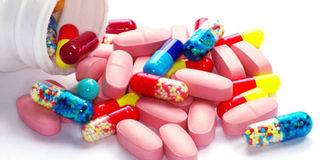Call for change in antibiotic use to reduce drug resistance

Irresponsible use of antibiotics has led to the rise of drug-resistant bacteria. PHOTO | FILE | NATION MEDIA GROUP
Antimicrobial resistance is a complex problem that requires a multidisciplinary team.
At the CGIAR AMR Hub that was launched at the International Livestock Research Institute (ILRI) in February, social scientists will conduct research on why and how people use antibiotics; veterinarians will improve health and promote the rational use of drugs; bioscience researchers will study how, where and why antimicrobial resistance occurs, and research alternatives such as vaccines, and human health personnel (doctors, health economists and political scientists) will work to ensure that the desired public health impact is achieved.
We spoke to Barbara Wieland, the Team Leader Herd Health, and interim lead CGIAR AMR Hub to shed more light on the problem of antimicrobial resistance (AMR):
Are there antimicrobial resistant bacteria in Kenya?
Yes, these are unfortunately increasingly common, in people, livestock and livestock products. Most of these are the result of people getting treated at hospitals or pharmacies, or from buying drugs and treating themselves without prescription. Some drugs no longer work for some diseases and other drugs are therefore being used. This also happens in livestock health and people then tend to follow a trial and error approach instead of conducting diagnostic resistance profiling.
When a disease is resistant to several antibiotics it is multi-drug resistant. At ILRI we often find multi-drug resistant bacteria in livestock, and people. A bacterium which is resistant to all known antibiotics is pandrug-resistant. So far there are only a few examples of pandrug-resistant bacteria (Klebsiella pneumoniae in the US and Pseudomonas aeuginosa in the UK). While these infections are fortunately still rare, there is a risk that they will become more common.
How prevalent is the problem of not adhering to drug withdrawal periods in livestock?
In Kenya, it’s mainly a problem in milk. In Ethiopia, a study showed that in some production systems, about eighty per cent of farmers consume milk before the withdrawal period after a cow’s course of antibiotics is over. It does not cause a lot of direct harm, as the small amounts of residues will not cause sickness. However, it does make it more likely that bacteria will become resistant. The problem of resistance is more likely to occur in communities were a lot of residues are consumed than in the individual who consumed the milk.
What are the implications of consuming produce from an animal that is on treatment?
Exposure to antibiotic residues happening many times over longer periods can result in selection for resistance. This can contribute to the risk of having human infections that don’t respond easily to treatment. The fact that you don’t see an immediate problem does not help in convincing producers not to sell such products.
We don’t know how big a problem this is – the relative importance of residues in contributing to selection of resistant bacteria compared to resistance due to antibiotics taken by people – but we know that infections with resistant bacteria are increasingly common and expensive to treat. However, most human resistant infections are the result of antibiotics given to people and not because of residues in animal sourced food or due to treatment of sick animals. But following the precautionary principle, it is good to avoid consuming residues and to minimise giving animals antibiotics.
Are there alternatives?
There is also ongoing research on alternatives to antibiotics such as phages (viruses that can kill bacteria) and probiotics (beneficial bacteria that suppress harm-causing bacteria). But we don’t yet understand the real benefits and how they will work in the long term. We also promote improved diagnostics as often disease is treated without a proper diagnosis, hence the wrong antibiotics are used or antibiotics are used unnecessarily.
What innovations are you exploring to reduce the use of antimicrobials?
We’re trying to address the problem from different angles: Addressing the key drivers of antibiotic use by farmers, such as high disease burden and trying to control and prevent this, and improving animal husbandry, nutrition and health. Better diagnostic tools can also reduce the need for antibiotics and in some cases, testing for antibiotic residues can help to identify poor farming practice. But we also need to increase awareness in producers and consumers.


